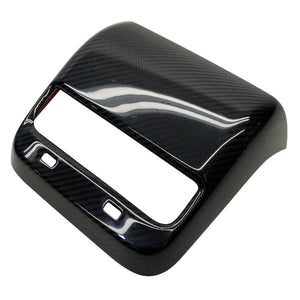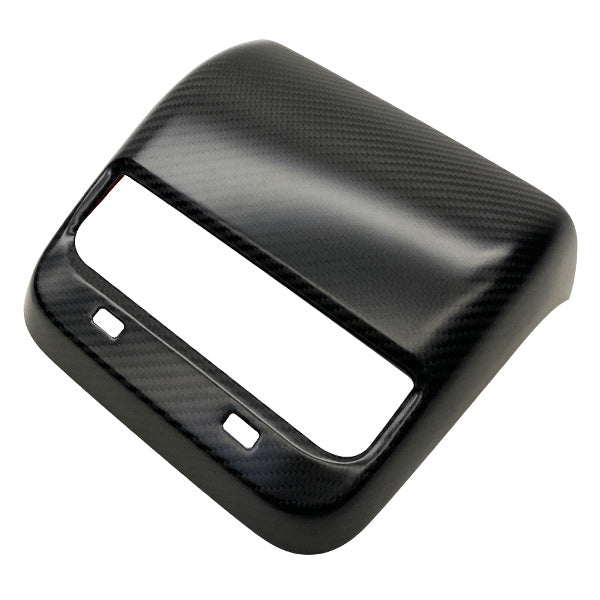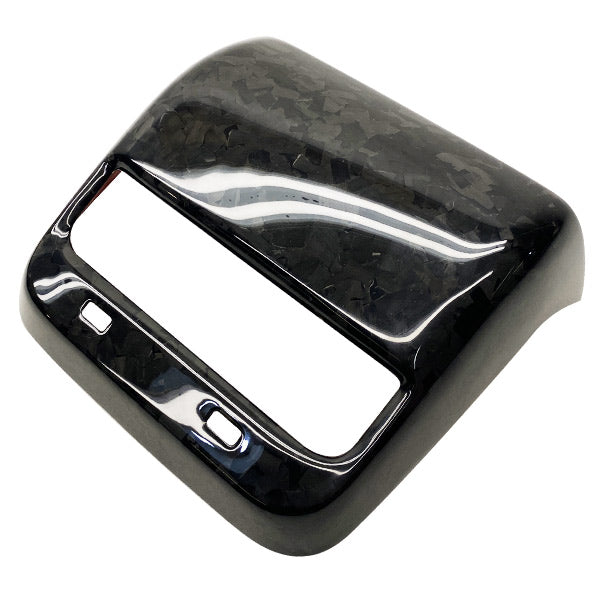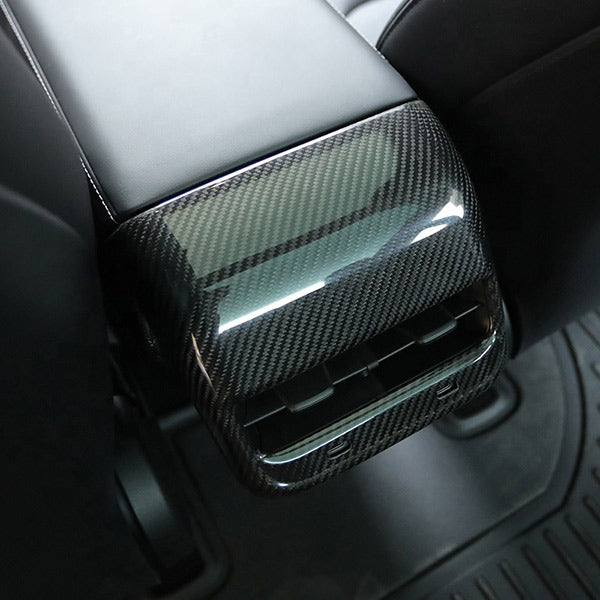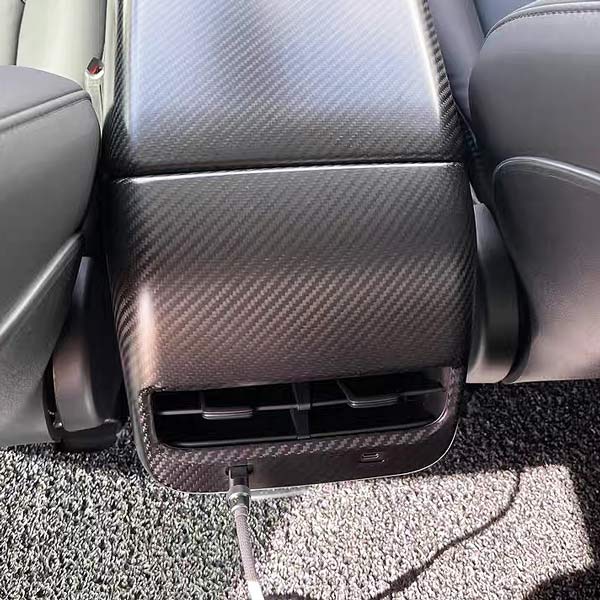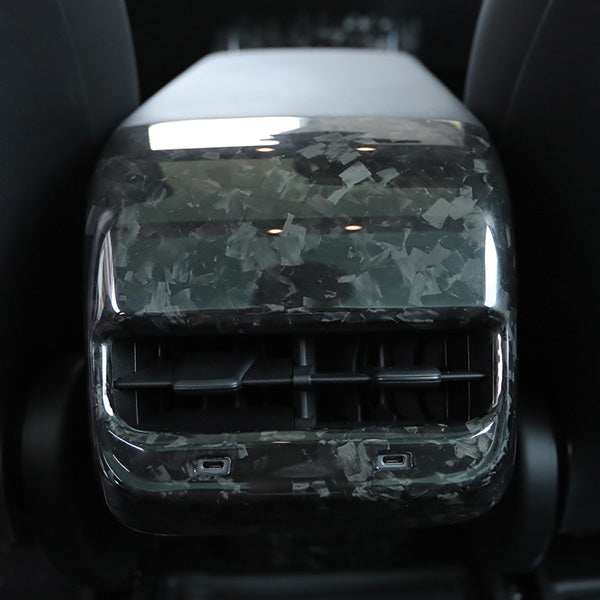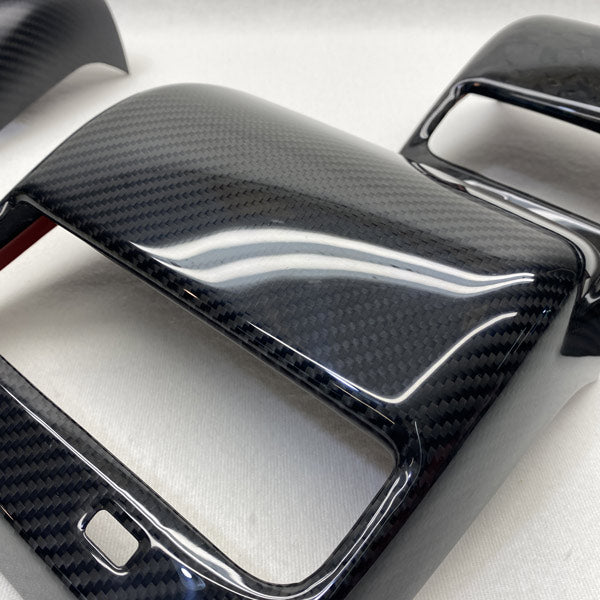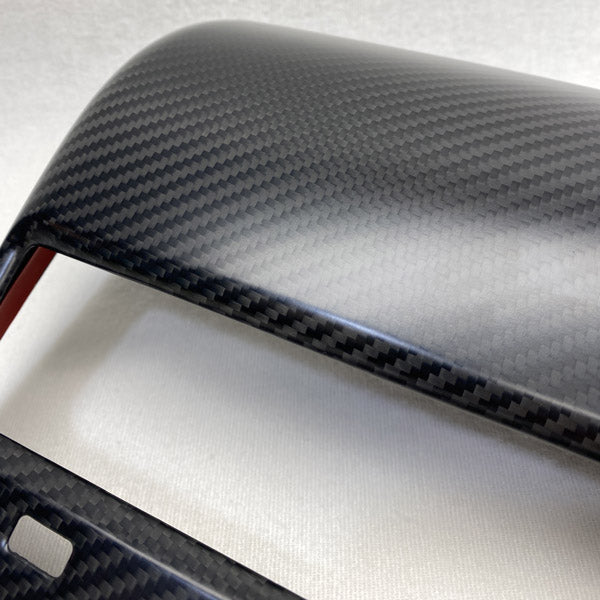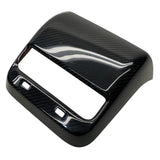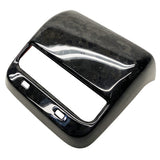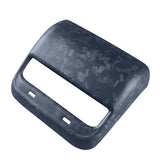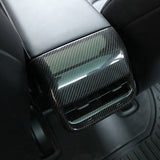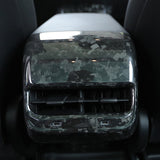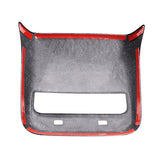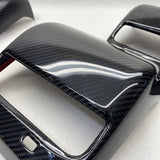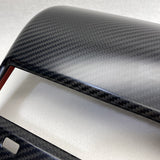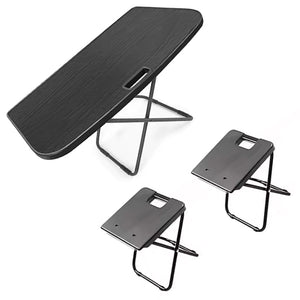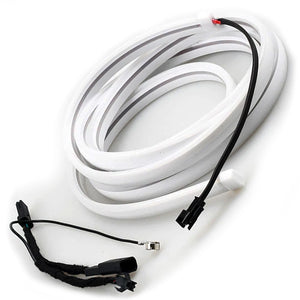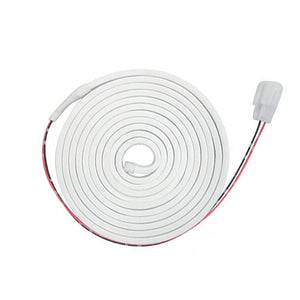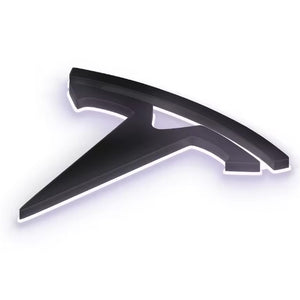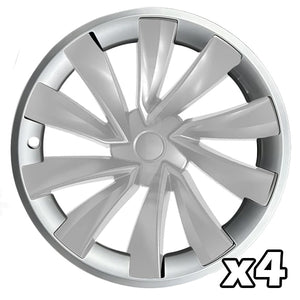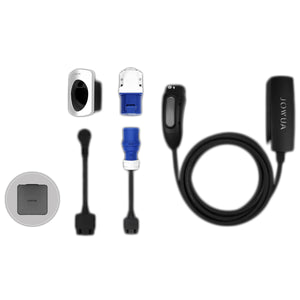Carbon rear console insert
Tesla Model 3 - Y
To complete a carbon preparation, this rear insert will finish your center console by simply sticking to the original part.This one is designed for Tesla Model 3 and Y any generation.
Precise cutting of your carbon elements
This is one of the essential characteristics to obtain the luxurious atmosphere linked to the carbon finish. The rear carbon console insert for Model 3 and Y is also entitled to remarkable cutting precision for a perfect fit.
Like the rest of the Model Sport carbon range, this element benefits from our know-how to benefit from a finish without paint, but in raw Epoxy resin, so as not to suffer the effects of time such as micro-scratches.
Characteristics of the rear part of the carbon console for Tesla Model 3 or Y
- Original design: changes the look of your Tesla
- Perfect finish: in real carbon
- Applies easily: durable 3M double-sided
- Does not leave glue residue after uninstallation
- Year of correspondence: Model 3 and Y version 2017-2020 and 2021-2023
-
2 year warranty
_________
Want to know what makes Model Sport carbon special? What does a composite material mean? A carbon part: what is its interpretation?
Let's present these ideas around three main axes:
• the true meaning of what is called a carbon element
• The singular vision of the Model Sport brand in the production of its carbon parts
The product will have no more secrets for you as soon as you have read this paragraph.
What is a composite material?
This type of elaboration is a good way to obtain an object with high mechanical properties while using two components that cannot mix with each other, but which can be associated.
What are the types of carbon or Texalium for your Tesla?
Carbon certainly has many variations and above all there are many ways to implement it.
You have to make a differentiation that will be important for purists: what is commercially nicknamed "carbon" actually has the name "carbon fiber composite", it is important to know that in the world of stratification it is this denomination that is used.
200 grams/m² 3K twill carbon fabric:

3K carbon in twill weave is undoubtedly the most common of its variety, let's start with this one. In other words, what is called "twill" is a name given to a certain way of weaving carbon.
To give you an idea, the figure just above shows you how each carbon weft and weave, with each other. Twill is the most widely used of weavings and for good reason, one of them is its maneuverability allowing it to adapt appreciably in a mold with pronounced shapes and curvatures. However, we will not detail the type of interlacing in 3/1, 2/2 and 4/4 for the sake of understanding.
The sign annotated "3K" designates the total number of filaments which constitutes a single carbon frame, in total unit: 3000 filaments. Information that will give you a more or less precise image of what the diameter of a strand of carbon evokes: 1/20th the thickness of a human hair, so take note of the importance of adding these .
1K, 3K, 6K and 12K are the most widely used varieties in the automotive, motorcycle, aviation or other types of carbon used in large industries. In the Tesla world, 3K is systematically the one used. As for the weight stated when selling a carbon sheet, if it is indicated "200gr/m²", this states the weight that 1m² of this sheet weighs before it is confused with a resin.
The combination of carbon characteristics that you come across the most is the twill weave in 3K and 200gr/m², not for its mechanical properties, but more for its aesthetics and its widespread use in many industries, which makes it makes it cheap.
Let's talk about forged carbon:
A qualification that may seem excessive for an aspect that is very divergent from the standards, however, this molding method is in no way innovative. To develop it, you must first cut the carbon into small strips and spread it more or less evenly in the mould.
At this, the resin is spread and then the whole thing is enclosed (the positive mold and the negative) and put under compression by increasing the temperature of the latter. This production process makes it possible to increase the density of carbon fiber per square centimeter compared to resin and thus gives a stiffer and lighter part.
You have to go back to the 80s to discover the first applications of forged carbon in the warhead manufacturing industry, however this production method was noticed only from its use at the Lamborghini brand .
Texalium, the unusual:
It is essential to make room for this material so taken for carbon. However, it is necessary to make the distinction of Texalium. It is in order to acquire the desired appearance that this material is in truth fiberglass loaded with aluminum, the resin or the varnish will then be dyed to give it a specific color.
You should know, however, that its mechanical properties are less than those of a usual glass fabric. And its use is purely aesthetic.
We don't have to wait for other countries to see a novelty arrive here, Texalium is no exception to the rule, because it has been widespread in the United States for a few years, when it is only just becoming known In France.
What does carbon look like visually?
With carbon fiber, what exactly is it possible to develop? Note that if you are interested in one of these versions, Model Sport remains open to customization and can therefore provide you with a quote.
What mechanical stress can be exerted on carbon?
An often asked question, perhaps in the wrong way, but rightly so. The real question will be whether carbon is more durable than another material? To give you an idea: an aluminum alloy that has a physical volume equal to a carbon part will be less durable than the latter, all constraints combined.
"Resistant" is a term that means everything and nothing. Because an aluminum part will perhaps behave better during impact, which will depend on the weaving used for the carbon in comparison. Carbon inserts are achievable for the simple and unique reason of their tolerance to torsion and bending.
For model 3 or Y, the dashboard cover insert is a very good example. Only two layers of carbon fabric are used to make a 1m40 long piece, which will be transported throughout the French country or to other border countries.
How to explain the price of carbon?
What is essential to explain in order to understand the price of carbon, we must go back to the operation of manufacturing it. The operation of making a single carbon fiber is already quite complex.
To give you a rough description of the stages of making a single carbon fiber, you have to start your work with a synthetic fiber called polyacrylonitrile, which will be oxidized and then logically calcined to give us this inimitable carbon fiber.
Be aware that this race for ecology gives rise to many projects to continue to use carbon fiber for its lightness, while guaranteeing production without chemicals.
The use of bio-sourced materials is fashionable and even more and more essential to meet certain environmental criteria put in place. The goal: the elimination of chemicals, but also a division of the price. The material required to weave the carbon fibers is also more than substantial, in terms of investment and space. Remember that a fiber is 1/20 the thickness of a human hair.
For information, the square meter of the carbon fabric is acquired at the price of 30 euros. This applies in particular to the 200 g/m² twill 3K carbon.
Don't forget that we must add to this the cost of the resin, which we will see can have totally variable prices depending on its quality, and also that very often, if not all the time, a part in carbon is produced in a multitude of webs. Then, the know-how of a laminator knowing how to install and put in good conditions the materials in question.
The carbon of Model Sport and its unique layouts
Mastering the stages of production is important to know the finished product, which is why we are addressing this subject. It takes knowledge of the actual shaping of an element to be able to guarantee a satisfactory result.
It is for this argument that the creator of the Model Sport brand, designer and bodybuilder, makes every effort to deliver its know-how in the field of carbon components.
Fabric or carbon chips for Tesla?
It goes without saying that the carbon fabric is expressly used for its aesthetic appearance rather than its mechanical skills. In the Tesla realm, most carbon parts will not be subjected to any torsion or bending stress.
These are elements intended to reflect the sportiness of the American brand. For the entire Tesla range, the constraints generated on the elements, even a body kit, will be largely absorbed, even on a so-called "low-end" carbon.
To date, there are multiple categorizations of carbon stiffness. But the most used being the "HR" or High Resistance for flexibility and versatility. For all the carbon parts of your Tesla, Model Sport is also based on this type of carbon which is very widespread and so practical on several points.
Very often, however, HR is combined with HM, for "High Modulus", which will be much lighter, but much more brittle. It is for this argument that it is combined. The parallel we can draw is forged carbon, which has superior mechanical function, but is used for its different aesthetics.
The important role that resin brings to assembly
Here we enter the most interesting area of this description: resin. The mass production of certain carbon elements is generally produced with polyester resin. It is inexpensive and withstands high heat fairly well.
It is this resin that is used to make exhaust cartridges for motorcycles, for example. Epoxy resin will significantly increase the strength of parts subjected to residual loads.
The various tests have established that one resin stands out among many others: anti-UV epoxy resin. It does not tarnish over time and maintains the true look of carbon. The aggressions of UV rays emitted by the sun will thus have no effect on your carbon parts, what is more, the appearance is more transparent.
And this detail really makes all the difference, because without this treatment, you will have a carbon part that will yellow over time. The appearance can be perfect when setting up the piece, but be careful as soon as summer arrives in force, it will gradually tarnish and become opaque. It must also be understood that the resin used will have a price directly related to its application, its quality and its durability.
At this stage, it is interesting to evaluate the selling price of such a product in France:
• 1kg of Polyester resin = 8 to 10€
• 1kg of Epoxy resin = 50 at €60
• The kilo of anti-UV Epoxy resin is worth between €55 and €65
What is the topcoat on a carbon part?
It must be said that this is the operation that closes the project. We are so meticulous that the initial project was to mass-produce carbon parts that did not require finishing varnish.
So once out of the mould, they had to be perfect. Which induces a very high and counterproductive scrap rate taking into account that the spirit of the Tesla brand is to mitigate pollution, so this waste was nonsense.
We then found a solution to "standardize" the finishing work: the use of a superior quality varnish. Once the gloss varnish has been applied, it will be carefully buffed to give it a polished surface. The mat, which does not benefit from any possible recovery thanks to polishing, is completed by a professional painter in one go.
Model S and X: their carbon preparation
At first glance, the two vehicles all have similar interior elements. However, a certain number of parts remain very singular depending on the year of registration.
So in most cases we call the owner, after ordering, to find out more information about the vehicle.
Model S and X interior
The Model S and X have been forgotten by props since the launch of the Model 3, however these also benefit from a range of upgrades provided.
The real carbon will be used to modify the dashboard, the areas around the center console or even other components to come in the future.
The predominant point, the steering wheel, can also benefit from customization with leather or Alcantara trim, depending on your choice. The latter will have a relatively precise customization, which many other accessories will be able to benefit from in the future.
Model S and X: bodywork components
The electric sedan par excellence first receives the Performance spoiler. In its matt version, you will have in all respects the appearance of that present on the Performance versions of the Model S, with the difference that that of Model Sport has a bonding surface and a unique internal structure.
Although the dissimilarities made on the parts mentioned are not visible once the spoiler is in place, it will have the benefit of effectively possessing the lightness provided by carbon. We are also currently working on the Plaid version as of this writing.
Smaller elements such as the mirror caps or the grille can benefit from their full carbon finishes. If you ever want a personalized creation based on Texalium or forged carbon, you can contact us by phone or email to find out more about your project on your Model S or X.
Model 3 and Y: perfect bases for carbon fabrication
The advent of carbon in the Tesla world has actually appeared since the launch of the Model 3.
Let's take a look at the similarities with the Model Y, which shares a lot of carbon accessories.
Model 3 and Y: their interiors and accessories
Carbon inserts are almost standard equipment for the Tesla community. It is an exercise in strength to be able to mass-produce carbon components that can cover a part while giving the impression that there is no addition. It is on this assumption that the quality of an insert must be judged.
The door, dashboard and other center console trims required a number of different tests to find the right method and the right mold to manufacture these inserts of incomparable quality. The keys to a quality insert lie in precise cutting and precision gluing.
Carbon replacement parts, however, are making more and more careful owners happy. The carbon replacement elements will give an entirely different dimension to the interior of your Tesla, for meticulous people, you will obtain a finish that meets your expectations.
Model 3 and Y: exterior upgrades
As with the interior, the exterior parts of the Model 3 and Y have the right to a good number of carbon parts made in series or custom-made. In a gloss or matte finish, with 3K twill or forged carbon, you can transform your entire Tesla.
As for the Model 3 and Y, the performance spoiler in its matte version is relatively coveted. To stick directly on the trunk (or trunk for the Model Y), it has become a standard for Tesla personalization.
You can also choose more advanced upgrades such as the real carbon front cover, an absolutely beautiful piece that will definitely save you weight, while keeping its use essentially functional.
- 🇫🇷 Gestionnaire Français
- Commandez directement au Fabricant ou au Distributeur
- Payez que votre produit (pas de frais de stockage ni de taxe territoriale)
- Livraison dans toute l'Europe !
Vous remarquerez que le bouton au-dessus vous redirige vers un des distributeurs ou fabricants du produit.
La major partie des accessoires Tesla proviennent de Chine, commander via les plateformes Aliexpress, Alibaba, Amazon, Hansshow ou Jowua vous donnera la possibilité d'obtenir le produit sans intermédiaire.
Les produits vendus en France ou en Europe proviennent du même fabricant Chinois (ou autre), mais avec une marge supplémentaire servant à payer les frais de fonctionnement de la société.
Cependant, l'avantage de commander à proximité est d'obtenir un délai de livraison plus rapide (néanmoins nous proposons aussi des produits expédiés directement depuis des stock Français ou Européens)
Model Sport a initialement commencé en faisant du stock en France, nous connaissons donc quels sont les fabricants de confiance et leur méthode de travail. Si bien que nous les citons avec leurs accords : MAOFA, BFB carbon, Yute Technologie, DCR Tuning, LITA Accessories, Jogon, Ever carbon, Carbonss Tuning, Jowua.
Ces fabricants, parmi quelques autres, sont les plus actifs et sérieux dans leur qualité de fabrication. Nous vérifions que les produits proviennent systématiquement de notre liste de fabricant. Ainsi, que vous commandiez via un distributeur Aliexpress, Amazon ou autre, nous savons que le produit sera de bonne facture.
